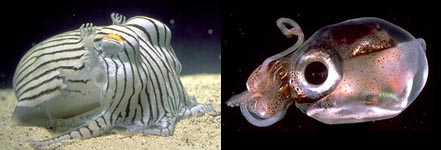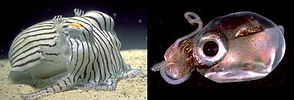Sepiolida
Michael Vecchione and Richard E. Young

This tree diagram shows the relationships between several groups of organisms.
The root of the current tree connects the organisms featured in this tree to their containing group and the rest of the Tree of Life. The basal branching point in the tree represents the ancestor of the other groups in the tree. This ancestor diversified over time into several descendent subgroups, which are represented as internal nodes and terminal taxa to the right.

You can click on the root to travel down the Tree of Life all the way to the root of all Life, and you can click on the names of descendent subgroups to travel up the Tree of Life all the way to individual species.
For more information on ToL tree formatting, please see Interpreting the Tree or Classification. To learn more about phylogenetic trees, please visit our Phylogenetic Biology pages.
close boxIntroduction
Members of the Sepiolida are short (mostly 2-8 cm ML), broad cephalopods with a rounded posterior mantle.
Diagnosis
A sepioid ...
- with a short, rounded body.
- without a cuttlebone.
Characteristics
- Head
- Eye pore outside of ventral eyelid.
 image info
image infoFigure. Lateral view of head of Rossia sp., 19 mm ML, female, preserved. Arrow points to eye pore.
- Mantle
- Dorsal margin fused to or free from head.
- Ventral mantle adductor present.
- Fins
- Fins broad (length ca. less than two times, usually equal to, individual fin width).
- Attachment of posterior fin-lobes broadly separated.
- Shell
- Shell a thin or rudimentary gladius or absent.
 image info
image infoFigure. Ventral view of mantle cavity of Rossia sp., preserved. Arrow points to the cut surface of the ventral mantle adductor where it had attached to the ventral mantle wall. Anteriorly the adductor muscles pass to either side of the intestine. Photograph by R. Young.
About This Page
National Marine Fisheries Service
Systematics Laboratory
National Museum of Natural History
Washington, D. C. 20560
USA
Richard E. Young
Dept of Oceanography
University of Hawaii
Honolulu, Hawaii 96822
USA
Page copyright © 2004 and Richard E. Young
- First online 21 August 2004
Citing this page:
Vecchione, Michael and Young, Richard E. 2004. Sepiolida . Version 21 August 2004 (under construction). http://tolweb.org/Sepiolida/23872/2004.08.21 in The Tree of Life Web Project, http://tolweb.org/







